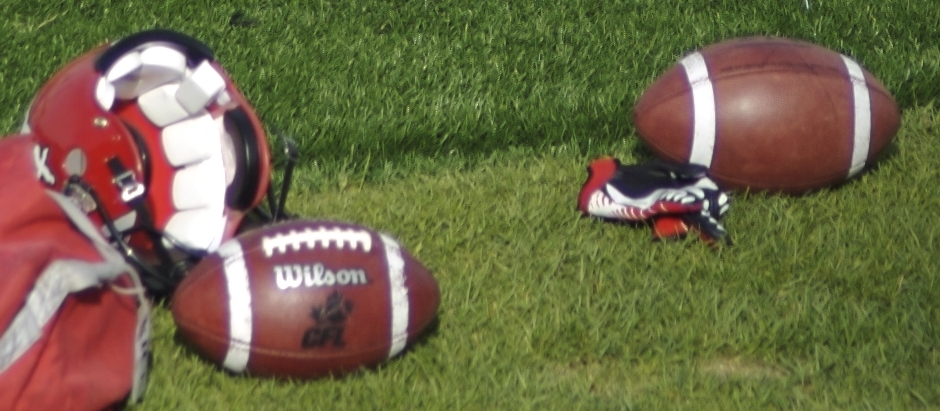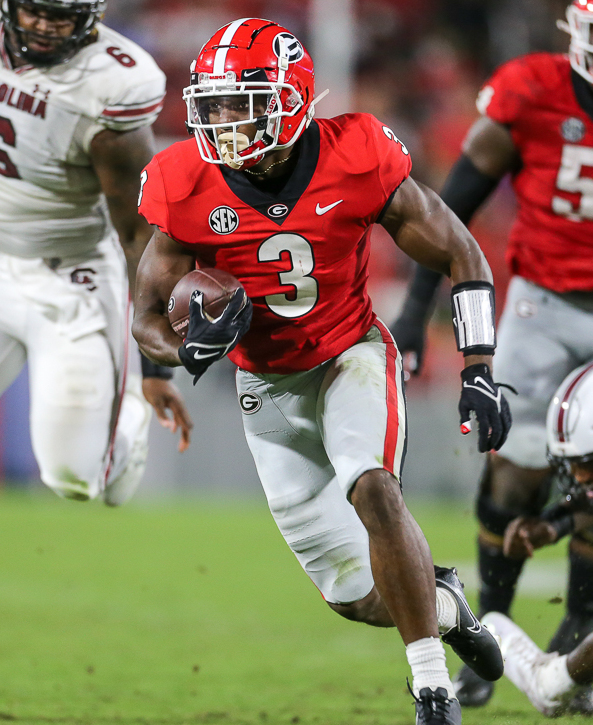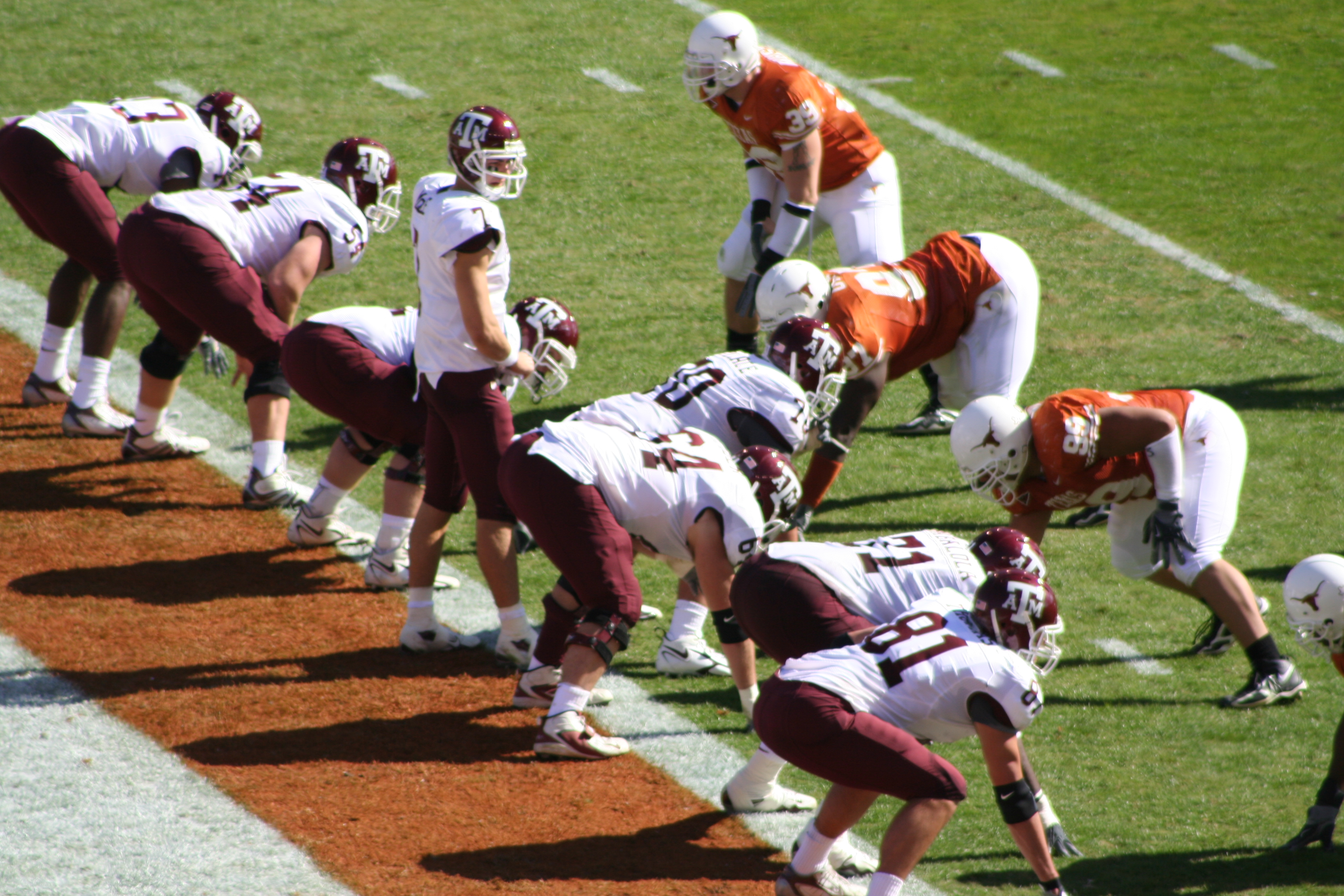|
Official (Canadian Football)
An official in Canadian football is a person who has responsibility in enforcing the rules and maintaining the order of the game, like their counterparts in the American game. In the Canadian Football League, seven officials operate on the field. Lower levels of play up to the university level use less than the standard seven. Football officials are commonly, but incorrectly, referred to collectively as referees, but each position has specific duties and a specific name: referee, umpire, head linesman (or down judge), line judge, back judge, side judge, and field judge. Because the referee is responsible for the general supervision of the game, the position is sometimes referred to as head referee or crew chief. The centre judge, used only in the United States in NCAA Division I college football and in the AAF during its single season, has not been used in Canadian football yet; the CFL used an eighth official (with no official position name) only during the 2018 playoffs, but tha ... [...More Info...] [...Related Items...] OR: [Wikipedia] [Google] [Baidu] |
Canadian Football
Canadian football () is a sport played in Canada in which two teams of 12 players each compete for territorial control of a field of play long and wide attempting to advance a pointed oval-shaped ball into the opposing team's scoring area ( end zone). In Canada, ''football'' may refer to Canadian football and American football collectively, or to either sport specifically, depending on context. Outside of Canada, the term Canadian football is used exclusively to describe this sport, even in the United States; the term '' gridiron football'' (or, more rarely, ''North American football'') is also used worldwide as well to refer to both sports collectively. The two sports have shared origins and are closely related but have some key differences. With the probable exception of a few minor and recent changes, for which there is circumstantial evidence to suggest the existence of at least informal cross-border collaboration, the modern rules of the two sports evolved independentl ... [...More Info...] [...Related Items...] OR: [Wikipedia] [Google] [Baidu] |
Running Back
A running back (RB) is a member of the offensive backfield in gridiron football. The primary roles of a running back are to receive handoffs from the quarterback to rush the ball, to line up as a receiver to catch the ball, and block. There are usually one or two running backs on the field for a given play, depending on the offensive formation. A running back may be a halfback (in certain contexts also referred to as a "tailback" — see below), a wingback or a fullback. A running back will sometimes be called a "feature back" if he is the team's starting running back. Halfback/tailback The halfback (HB) or tailback (TB) position is responsible for carrying the ball on the majority of running plays, and may frequently be used as a receiver on short (or sometimes long, depending on the system) passing plays. In the modern game, an effective halfback must have a blend of both quickness and agility as a runner, as well as sure hands and good vision up-f ... [...More Info...] [...Related Items...] OR: [Wikipedia] [Google] [Baidu] |
106th Grey Cup
The 106th Grey Cup (branded as the 106th Grey Cup presented by Shaw for sponsorship reasons) was the Canadian Football League (CFL) championship game for the 2018 season. It was played on November 25, 2018, between the Ottawa Redblacks and the Calgary Stampeders at Commonwealth Stadium in Edmonton, Alberta. In a rematch of the 104th Grey Cup, the Stampeders won 27–16, claiming their eighth Grey Cup Championship. Host city Selection process On March 24, 2017, it was reported by several news outlets that the Calgary Stampeders and Edmonton Eskimos were bidding to host the 2018 Grey Cup game. In previous years, the games would be awarded based on regional preference or ownership changes (such as Toronto hosting the 104th Grey Cup four years after hosting their previous one). However, beginning with the 2018 game, the League announced it would conduct a formal bidding process based on the merits of the application to determine a host. Calgary last hosted the Grey Cup in 20 ... [...More Info...] [...Related Items...] OR: [Wikipedia] [Google] [Baidu] |
Defensive Back
In gridiron football, defensive backs (DBs), also called the secondary, are the players on the defensive side of the ball who play farthest back from the line of scrimmage. They are distinguished from the other two sets of defensive players, the defensive linemen who play directly on the line of scrimmage, and the linebackers, who play in the middle of the defense, between the defensive line and the defensive backs. Among the defensive backs, there are two main types, cornerbacks, which play nearer the line of scrimmage and the sideline, whose main role is to cover the opposing team's wide receivers, and the safeties, who play further back near the center of the field, and who act as the last line of defense. American defensive formations usually includes two of each, a left and right cornerback, as well as a strong safety and a free safety, with the free safety tending to play further back than the strong safety. In Canadian football, which has twelve players on the field com ... [...More Info...] [...Related Items...] OR: [Wikipedia] [Google] [Baidu] |
Lateral Pass
In gridiron football, a lateral pass or lateral (officially backward pass in American football and onside pass in Canadian football) occurs when the ball carrier throws the football to a teammate in a direction parallel to or away from the opponents' goal line. A lateral pass is distinguished from a forward pass, in which the ball is thrown forward, towards the opposition's end zone. In a lateral pass the ball is not advanced, but unlike a forward pass a lateral may be attempted from anywhere on the field by any player to any player at any time. While the forward pass is an invention of the North American games, the lateral and backward pass is also a part of rugby union and rugby league, where such passes are the norm. Compared to its use in rugby, laterals and backward passes are less common in North American football, due to a much greater focus on ball control in American football strategy; they are most commonly used by the quarterback, after taking the snap, to quickly t ... [...More Info...] [...Related Items...] OR: [Wikipedia] [Google] [Baidu] |
Forward Pass
In several forms of football, a forward pass is the throwing of the ball in the direction in which the offensive team is trying to move, towards the defensive team's goal line. The forward pass is one of the main distinguishers between gridiron football (American football and Canadian football) in which the play is legal and widespread, and rugby football (union and league) from which the North American games evolved, in which the play is illegal. The development of the forward pass in American football shows how the game has evolved from its rugby roots into the distinctive game it is today. Illegal and experimental forward passes had been attempted as early as 1876, but the first legal forward pass in American football took place in 1906, after a change in rules. Another change in rules occurred on January 18, 1951, which established that no center, tackle, or guard could receive a forward pass, unless such a player announces his intent to the referee beforehand that he w ... [...More Info...] [...Related Items...] OR: [Wikipedia] [Google] [Baidu] |
Chain Crew
In gridiron football, the chain crew (commonly known as the "chain gang") is a crew that manages signal poles on one of the sidelines. There are three primary signal poles: the "rear rod" that marks the beginning of the current set of downs, the "forward rod" that marks the line to gain, and the "box" that marks the line of scrimmage. The two rods are attached at the bottom by a chain exactly ten yards long, while the "box" displays the current down number. The chain crew, under the direction of the head linesman/down judge, signals the officials' decisions; it does not make decisions. Players look to the chain crew to see the line of scrimmage, the down number, and the line to gain. Officials may rely on the chain crew after a play (incomplete pass or penalty) whose outcome depends on the original spot of the ball. This also includes bringing the chains onto the field whenever an accurate measurement is needed to determine if a first down has been made. Members Three members ... [...More Info...] [...Related Items...] OR: [Wikipedia] [Google] [Baidu] |
Line Of Scrimmage
In gridiron football, a line of scrimmage is an imaginary transverse line (across the width of the field) beyond which a team cannot cross until the next play has begun. Its location is based on the spot where the ball is placed after the end of the most recent play and following the assessment of any penalty yards. History The line of scrimmage first came into use in 1880. Developed by Walter Camp (who introduced many innovations that are part of the modern game of American football), it replaced a contested scrimmage that had descended from the game's rugby roots. This uncontested line of scrimmage would set into motion many more rules that led to the formation of the modern form of gridiron football (although the Canadian rules were developed independently of the American game, despite their similarities). Dimensions A line of scrimmage is parallel to the goal lines and touches one edge of the ball where it sits on the ground before the snap. In American football, th ... [...More Info...] [...Related Items...] OR: [Wikipedia] [Google] [Baidu] |
Lineman (football)
In gridiron football, a lineman is a player who specializes in play at the line of scrimmage. The linemen of the team currently in possession of the ball are the offensive line, while linemen on the opposing team are the defensive line. A number of NFL rules specifically address restrictions and requirements for the offensive line, whose job is to help protect the quarterback from getting sacked for a loss, or worse, fumbling. The defensive line is covered by the same rules that apply to all defensive players. Linemen are usually the largest players on the field in both height and weight, since their positions usually require less running and more strength than skill positions. Offensive line The offensive line consists of the center, who is responsible for snapping the ball into play, two guards who flank the center, and two offensive tackles who flank the guards. In addition, a full offensive line may also include a tight end outside one or both of the tackles. An offen ... [...More Info...] [...Related Items...] OR: [Wikipedia] [Google] [Baidu] |
Coin Flipping
Coin flipping, coin tossing, or heads or tails is the practice of throwing a coin in the air and checking which side is showing when it lands, in order to choose between two alternatives, heads or tails, sometimes used to resolve a dispute between two parties. It is a form of sortition which inherently has two possible outcomes. The party who calls the side that is facing up when the coin lands wins. History Coin flipping was known to the Romans as ''navia aut caput'' ("ship or head"), as some coins had a ship on one side and the head of the emperor on the other. In England, this was referred to as ''cross and pile''. Process During a coin toss, the coin is thrown into the air such that it rotates edge-over-edge several times. Either beforehand or when the coin is in the air, an interested party declares "heads" or "tails", indicating which side of the coin that party is choosing. The other party is assigned the opposite side. Depending on custom, the coin may be caught; cau ... [...More Info...] [...Related Items...] OR: [Wikipedia] [Google] [Baidu] |
Overtime (sports)
Overtime or extra time is an additional period of play specified under the rules of a sport to bring a game to a decision and avoid declaring the match a tie or draw where the scores are the same. In some sports, this extra period is played only if the game is required to have a clear winner, as in single-elimination tournaments where only one team or players can advance to the next round or win the tournament. The rules of overtime or extra time vary between sports and even different competitions. Some may employ " sudden death", where the first player or team who scores immediately wins the game. In others, play continues until a specified time has elapsed, and only then is the winner declared. If the contest remains tied after the extra session, depending on the rules, the match may immediately end as a draw, additional periods may be played, or a different tiebreaking procedure such as a penalty shootout may be used instead. The terms ''overtime'' and ''in overtime'' (abb ... [...More Info...] [...Related Items...] OR: [Wikipedia] [Google] [Baidu] |
Instant Replay
Instant replay or action replay is a video reproduction of something that recently occurred which was both shot and broadcast live. The video, having already been shown live, is replayed in order for viewers to see again and analyze what had just taken place. Some sports allow officiating calls to be overturned after the review of a play. Instant replay is most commonly used in sports, but is also used in other fields of live TV. While the first near-instant replay system was developed and used in Canada, the first ''instant'' replay was developed and deployed in the United States. Outside of live action sports, instant replay is used to cover large pageants or processions involving major dignitaries (e.g. monarchs, religious leaders such as the Catholic Pope, revolutionary leaders with mass appeal), political debate, legal proceedings (e.g. O.J. Simpson murder case), royal weddings, red carpet events at major award ceremonies (e.g. the Oscars), grandiose opening ceremoni ... [...More Info...] [...Related Items...] OR: [Wikipedia] [Google] [Baidu] |








.jpg)
